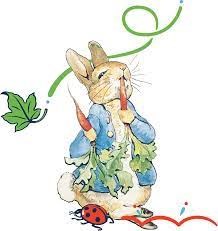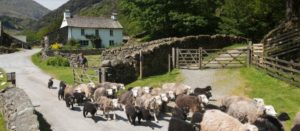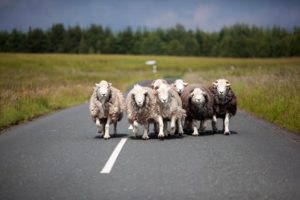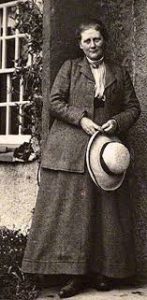The Smiley-Faced Sheep of Beatrix Potter
by Cathy Koos
 Most of us grew up on the delightful adventures of Jemima Puddle Duck, Peter Rabbit and Farmer MacGregor, the fanciful characters in Beatrix Potter’s children’s books. But did you know Beatrix was also responsible for singlehandedly conserving the nearly wild and ancient breed of Herdwick sheep. Genetically considered wild, this 10,000-year-old breed of sheep has populated the slopes of the Lake District in England since about 800 CE when the Vikings brought them, and 90% of the world’s herd resides there.
Most of us grew up on the delightful adventures of Jemima Puddle Duck, Peter Rabbit and Farmer MacGregor, the fanciful characters in Beatrix Potter’s children’s books. But did you know Beatrix was also responsible for singlehandedly conserving the nearly wild and ancient breed of Herdwick sheep. Genetically considered wild, this 10,000-year-old breed of sheep has populated the slopes of the Lake District in England since about 800 CE when the Vikings brought them, and 90% of the world’s herd resides there.
![]()

UK National Trust
Hardy Breed. With abundant rainfall and high-altitude mountains, the Herdwick sheep are brilliantly adapted to the harsh conditions. Small ears, wooly faces, and thick stocky legs keep body heat contained and their double coat of wool provides waterproof protection against the elements.
Back in the 1960s, one flock of Herdwicks survived alone for three winter months, stranded in the snow on a mountainside, only surviving on moss and lichens.
Another vital adaptation is that the ewes generally give birth in harsh weather because there are less predators. They usually give birth to singles, which improves lamb survival as the mother can immediately care for the newborn lamb, instead of waiting for a twin to birth before caring for the babies.
Norse Origins. Herdvyck was the old Norse name for the sheep breed, reflecting their ancient heritage. Viking raiders originally brought these hardy sheep with them – can you just imagine that wild boat ride. Over the centuries the Herdwicks wandered the fells, grazing freely on one of the few remaining common land systems.

UK National Trust
Fleece. Born black, the yearling or hogg fleece turns a dark chocolate brown while their head turns white in color. As the sheep age, their thick wiry fleece turns a tweedy mix of greys, browns, blacks, and white. The wool is like a scouring pad and more suited to rugs rather than garments. The primary value is in excellent meat, attracting the interest of fine restaurants, celebrity chefs, and even on the Queen’s dining table.
Miss Potter. Enter onto the scene with Beatrix Potter. She first encountered these delightful sheep as a child on family holiday and was entranced by their smiley clown faces. By the time Potter returned to the Lake District as an adult in the early 1900s, the Herdwick sheep population had dwindled to a few hundred head. By then, Beatrix was a wealthy, popular writer of children’s books as well as writing and illustrating scientific ecology publications. She was also an early innovator on merchandising and licensing products from her Peter Rabbit books.

UK National Trust
Potter was an early pioneer in ecology and preserving the farming economy. Using her husband’s name, most people in the area did not equate this humble woman dressed like a farmer with the wildly popular writer, and she was readily accepted into the community. After purchasing her first home and farm at Hill Top, she began to buy up other farms in the district with the intent of retaining them as working farms, eventually buying up fourteen farms. She then took on building up the remaining Herdwick sheep flocks and by the time of her death in 1943 the Herdwick sheep numbered in the thousands.
Potter left her Hill Top home and the fourteen farms to the National Trust and UNESCO recently awarded the Lake District region a World Heritage status to preserve its ecology and farming way of life. Currently, there are 60,000 breeding ewes worldwide, with 40,000 on farms gifted to the National Trust by Potter.
The current managers of Potter’s farm are Jon and Jo Watson. They have been caretakers of the National Trust’s 1000-head flock at Potter’s Yew Tree Farm for a couple of decades and have learned all the quirks of these nearly wild sheep.
While Potter was an amazing writer and illustrator, she also had the sharp acumen of a businessperson and the forward-thinking ability to recognize consequences of current land use practices and the value of heritage sheep, and she was not afraid to be a change maker.
For next page click here